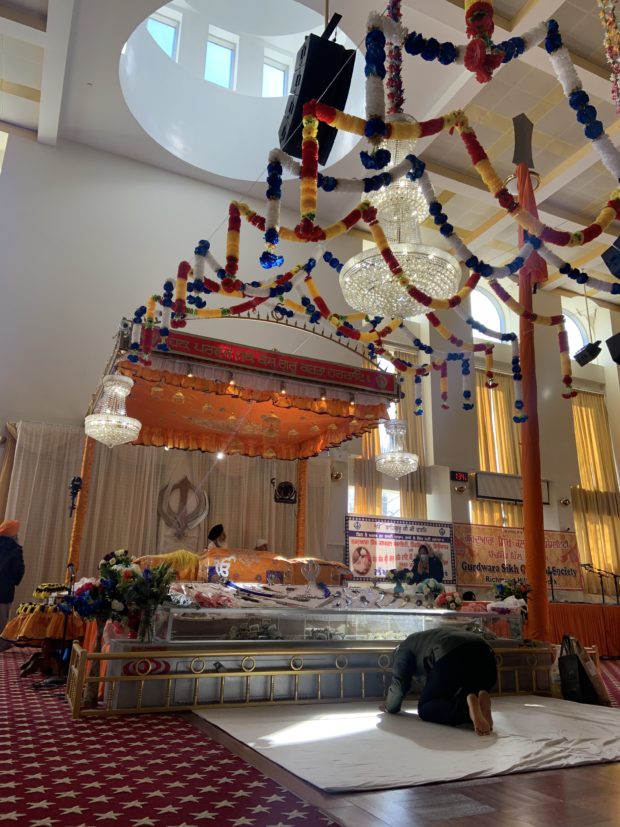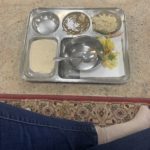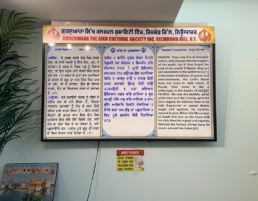During COVID-19, a Gurdwara in Queens Informs and Feeds
Like houses of worship all around New York City, the Sikh temple on 97th avenue in Queens was closed in the first months of the COVID-19 pandemic. There was no service, no washing, no head covering, no offerings.
But one element of the Sikh temple continued.
The gurdwara’s kitchen stayed open to serve meals to the city’s essential workers and members of the Black Lives Matter movement. At a time when many people did not have access to meals, the kitchen was open 12 hours a day, seven days a week. Such a kitchen operation, run by Sikh volunteers, is known as langar.
Japneet Singh, a Sikh activist and community member of District 28 in Queens, estimates that 100,000 meals were distributed from March 2020 to March 2021.
In Fall 2020, the congregation resumed prayer within the halls of the temple, known as a gurdwara, but with a new accessory: masks. They were largely hesitant to participate in langar so instead bowed in the Darbar Sahib prayer hall and left—forgoing an integral part of the faith’s routine.
Their skepticism came from evidence. In January 2021, the Richmond Hill section of Queens had one of the highest COVID-19 positivity rates across the city. This rate lingered. The community saw spiked rates because it is made up of an immigrant population with a large proportion of essential workers.
Singh, who ran for City Council in 2021, lost the primary election. Democratic opponent, Adrienne Adams, resumed her incumbency. According to Singh, no one from the city government came to the gurdwara to inform the community or train them on the health protocols to undertake during this time. Pamphlets were provided by the city but were not translated for the community that understands Punjabi, Hindi or Urdu, he said. Community members took to using the gurdwara as a site for distributing personal protective equipment such as masks and hand sanitizer.
The neighborhood was without a vaccine or testing facility until community leaders advocated for them. When they were unable to get them from the city, they reached out to third parties. Mobile vaccination vans, also offering testing, were set up outside the gurdwara in 2021.
Today, as COVID-19 positivity rates stabilize across the city, the vaccine vans are a less common sight. On Sundays, the day when Sikhs are off from work and find the time to worship en masse, they walk past a desk in the corner of the gurdwara, where two city employees sit, offering COVID resources like literature for the community.
Worshipers today will also notice a small, black webcam propped tall on a stand before the priests. The Sikh Cultural Society has over 7,500 followers on its Facebook page and uploads its prayer sessions to the page. The page’s photo gallery is also packed with images displaying the day’s holy scripture, hukam.
These technological innovations were started prior to the pandemic, at the suggestion of the head Granthi, or ceremonial protector of the Sikh holy book, to meet the needs of the community. At one point, WhatsApp Messenger, which is popular among the South Asian community, was used to deliver the daily hukam, but Facebook provides a larger reach.
Today, Singh, who is running for election in State Senate District 17, notices more food pantries popping up across the city. He recalls the efforts he witnessed from his community and is hopeful about the next stage.
“Humanity is a beautiful thing,” he said. “We can climb out of the hardest of hard.”
Sikhs in Queens Pay Tribute to Prominent Figures Old and New
On Sunday at The Sikh Cultural Society gurdwara at 118th Street in South Richmond Hill, Queens, a crowd of Sikh worshippers slip off their shoes and make their way to the Darbar Sahib for the day’s service. The women, many displaying their gold-adorned kurti tops, sit to the left of the hall. Men sit scattered on the burgundy carpet to the right of the room in rows. Their vibrant turbans in orange, turquoise, yellow and white dot half of the massive hall.
Though each worshiper performs daily readings on their own, they gather en masse at the gurdwara to learn from the Granthi’s interpretation of the Guru Granth Sahib. Granthis serve as guardians over the Sikh holy book, Guru Granth Sahib. Before the devoted hear the scripture, they see it. The seafoam green walls in the main hall display the day’s scripture in the Punjabi Gurmukhi script. Beside it is the English translation. This hukam, as it is called, is chosen at random and serves as the day’s guiding principle. Later on in the service, the gurus will recite and decipher the meaning.
There is a celebration of both life and death occurring on this Sunday. The usual crowd looms larger than previous ones. The seventh guru, Har Rai Sahib Ji, has a birthday. For Sikhs, this guru who died in the 17th century is revered for his military leadership. Across the hall from the hukam are images plastered in remembrance of Deep Sidhu, a famous Indian actor, lawyer and activist, who died the same week. Sidhu had been vocal in the recent Indian farmers’ protest about his support for the working class farmers against the Indian government. He is also a hero to those of Sikh faith.
The afternoon prayers begin with a memorial service to the late actor and activist. A man behind a podium makes a booming speech in Punjabi into a microphone. As he stands behind the podium addressing the room, he is being live-streamed online. He informs the youth in the room about Sidhu’s efforts, encouraging them to advocate for their beliefs like Sidhu. This message fell in line with a Sikh core tenet and practice, which is service to humanity and political activism.
The service transitions to singing from the youth. Six girls and two boys sing kirtan, songs of praise to God. Two girls in front played the harmoniums while off to the corner, one boy knocked the tabla drums to a beat. The song is chosen at random days before but prepared and sung according to the mood. Before harmoniums were introduced by the British to India, string instruments were played by the Sikh women for this practice. The harmoniums are easier to play but the string instruments require a skilled craft to turn out musical notes.
The worshipers sing along to the hymns but most make the descent to the basement’s kitchen for langar. When they return, the reading from Guru Granth Sahib is underway. In the prayer room, the elephantine book sits higher than everyone else. As a holy text, it must always be elevated. The Granthi sits behind it; his black turban peeping from the backdrop of a gold khanda, the Sikh symbol of swords. People stand with their hands clasped listening to the Granthi recite from the holy book in Punjabi. Once allowed to sit, they retreat to the carpet—legs crossed, listening intently.
 The Granthi is joined by a second Granthi who serves as the translator of the sacred text. In Punjabi, he explains what was just read from the scripture. All the while, the guardian of the holy text steadily waves a large canary yellow scepter, known as a chaur sahib, around the book. The chaur sahib is a ceremonial ornament that on one end is bejeweled and on the other, extended with animal hair that bears a strong resemblance to a horse’s tail.
The Granthi is joined by a second Granthi who serves as the translator of the sacred text. In Punjabi, he explains what was just read from the scripture. All the while, the guardian of the holy text steadily waves a large canary yellow scepter, known as a chaur sahib, around the book. The chaur sahib is a ceremonial ornament that on one end is bejeweled and on the other, extended with animal hair that bears a strong resemblance to a horse’s tail.
Faint whispers can be heard throughout the hall as people recite the scripture to themselves. Some younger Sikhs follow the words on apps on their phone. Then they all join in song. Some vocals pitch higher in the crowd and they sing out loud alone, as the music moves them.
Afterwards, people line up on the long wood panel corridor and prepare to bow and make optional donations in front of the shrine where the Granthi sat protecting the holy book. Once the initial bowing is over, some travel around the holy shrine area where they make additional bows and prayers around the square. A final prayer is said, internally or through a pale voice, at a pole dressed with the bright orange nishan sahib flag, where hands make a delicate touch before parting from the area.
When the service is over, the Guru Granth Sahib is draped with a vivid orange cloth beaded in Indian designs, known as the rumala, awaiting its removal to the upper floor of the gurdwara, where it will stay enclosed in a locked room until morning comes again.
A Sunday Langar Brings Together Sikhs in Queens
Midday on a recent Sunday, The Sikh Cultural Society in Richmond Hill, Queens, is packed with the faithful. They come to pray, to socialize and to eat in a religious ceremony called langar—the communal meal shared after the prayers.
Everyone in the gurdwara is barefoot and wears a head covering. As worshipers enter the main service room, known as the Darbar Sahib, a man in a white linen gown scoops up a healthy portion of a sacred treat called parshad and places it in my bare, cupped hands. I rise and make my way to the opposite side of the room. Women on the left. Men on the right.
This separation, I am told, is done at some gurdwaras out of respect, to avoid distraction and to allow worshipers to feel comfortable, should their shirts rise when kneeling to pray or if they need to breastfeed a child. “It’s a completely cultural practice,” one worshiper, Tandeep Kaur, told me in a phone conversation. “It doesn’t have any religious background.”
After exiting the room of worship, I go down the stairs with other worshipers for the langar.
I grab a metal tray that comes complete with a metal bowl, metal spoon and napkin. This begins my experience with langar. The basement of the gurdwara serves as a community kitchen where volunteers cook the multiple meals and wash the hundreds of dishes. The Sikh house of worship and its kitchen are open continuously to anyone regardless of their faith.
I am directed by an elder volunteer to a spot on a burgundy runner rug.
Clink!
That is the sound the metal tray makes on the floor before me. My feet and legs then fold into the sukhasana position. In the Sikh faith, everyone sits on the floor, regardless of their identification, to show that all are equal. The practice has its origins in deconstructing the idea of the caste system.
 In the gigantic basement, a few single wooden benches and tables are around for those who can not physically descend to the ground. I sit in between a middle-aged man and woman who are unrelated. The wall in front of me is decorated with framed images of the gurus. My eyes track a little further where I spot a television broadcasting the prayers in the Darbar Sahib to those of us in the eating area.
In the gigantic basement, a few single wooden benches and tables are around for those who can not physically descend to the ground. I sit in between a middle-aged man and woman who are unrelated. The wall in front of me is decorated with framed images of the gurus. My eyes track a little further where I spot a television broadcasting the prayers in the Darbar Sahib to those of us in the eating area.
The lentil soup’s overpowering spices of cumin and cloves linger in my mouth. This is the dhal. Covering my plate is a sweet-tasting cheese and green pea curry called matar paneer, salad, peas pulao (lentil rice) and a dessert of rice pudding, called kheer. The pani, or water, sits in a metal bowl from the set awaiting consumption from the diners.
As we eat, the barefooted men make the rounds again with their vats of water, dhal, kheer, rice, parathas and salad asking those sitting if they would like additional servings.
After the meal, I get up and grab some hot chai (tea). I pace, unaware of where to stand or sit when a male volunteer gestures to me to have a seat at the end of yet another sliver of carpet. I thank him and seat myself at the far end of the reddish rug I have now grown accustomed to. I am in a row of men also sipping their chai and chatting or quietly contemplating. Around me are the voices of young children running around discussing their allowance, grades and what latest sneaker their good grades will allow their parents to buy for them.
In my stocking feet, I make my way up the stairs and through the long corridor before sharply turning right to retrieve my clothes. I get dressed and walk the pavements of Richmond Hill before stopping to visit the sign: Punjab Avenue.



